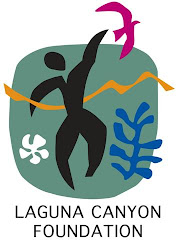Friday, November 3, 2006
Nature's new scene
Coastal foothills never before open to the public soon will be, along with a brand new nature center building.
By PAT BRENNAN
The Orange County Register
Wild country closed to the public for decades is about to be opened up, offering nature enthusiasts a new window into Orange County's coastal scrub and oak-covered foothills.
And in this case, it really will be a window – actually a few of them. They'll be a central feature of the new Nix Nature Center near the heart of Laguna Canyon.
Organizers call these windows “portals,” part of an exhibit that takes visitors on a breezy trip through science, art and history.
The public will get its first glimpse Saturday in a dedication ceremony, although the official opening date is still uncertain. One of the first things visitors are likely to notice about the place: an intense focus on the natural landscape.
“It's about the land and not about the people,” said Mary Fegraus, executive director of the Laguna Canyon Foundation and a driving force behind the new center. “People get to talk all the time. This is a chance to let the land talk.”
The Nix Center, named after a Laguna Woods couple who provided $500,000 to build it, will be the jumping-off point for access to new trails in the northern portion of Laguna Coast Wilderness Park, never before open to the public. Hikers and bikers will be able to explore more of the foothill country between the San Joaquin (73) Toll Road and the San Diego (I-405) Freeway.
They'll also be able to explore the land around Orange County's only natural lakes. The newly realigned Laguna Canyon Road shifts traffic out of the old, two-lane roadway in the canyon bottom, moving it west. There are now two lanes in each direction with a buffer between, and underpasses that will allow public access to the lakes for the first time.
This week, construction workers were still sawing and hammering, artists were touching up murals, and landscapers were preparing to plant native bunch grasses. (Ed note: These grasses were grown, bumped up and planted by the Nursery volunteers.)
Not everything will be completed in time for Saturday's event, Fegraus said. But visitors should get a taste of the carefully prepared exhibit and the land around the new center. They'll be encouraged to hike and explore, she said.
The portal theme is one of the most striking aspects of the center; organizers say the unusual approach is a bit of a risk, but one they hope will grab visitors' attention.
The idea is to look through conceptual “portals” that represent a variety of viewpoints about the land that surrounds the center. The real, physical portals, an array of broad windows and an outdoor metal frame, are meant to focus visitors' attention on specific landscape features.
The canyon country's history – natural and human – has filled volumes, and Jennifer Rigby, director of the Acorn Group, who wrote the text for the exhibit as well as helping design it, said she knew from the start that she would be unable to cover it all in the center's 2,000-foot-square space.
Then she thought of the portals. By looking at the surrounding landscape from a scientist's point of view, then an artist's, then a historian's, visitors could get a kind of high-altitude snapshot of the many ways of seeing Orange County's rugged, natural country.
The three streams of viewpoint braid their way through the exhibit space. Visitors pass artificial rocks embedded with casts of fossils, a sweeping landscape mural, and a flat-topped boulder with a pestle, where visitors can try their hands at grinding corn.
Short films projected on screens and a room of plein-air paintings will complete the presentation. A deck outside is meant for artists who wish to paint the landscape.
Scientists and members of local American Indian tribes served as advisors for the exhibit. So it provides a taste of geological history as well as tribal lore – how animals on the land, for example, correspond to symbols and characters from ancient stories.
The exhibit is light on a few things, such as details of archaeological findings in the area, or an in-depth treatment of more recent history – some controversial development decisions, for example.
Rigby said she steered away from several matters of controversy, but not for fear of giving offense. Instead, she said she wanted to stay true to the center's purpose: whetting visitors' appetite for a trip outside, not bogging them down with lengthy lectures.
“It's causing visitors to start asking some of their own questions,” Rigby said during a visit to the center last week.
The exhibit includes a detailed landscape mural by Katy Betz, a graduate of the Laguna College of Art and Design; just outside, a half-mile loop trail will allow even casual visitors to experience the real thing.
The seed money from James and Rosemary Nix, who visited the canyon frequently over 25 years, helped gain more funding from state park bonds and the Laguna Canyon Foundation to cover
Originally, the center was supposed to be built on top of a nearby hill. But when Nix, a park ranger and members of the Laguna Canyon Foundation came to check out the site in 2003, they were drawn instead to a hollow surrounded by spectacular views.
“We said, ‘This is the location,' ” said James Nix, 88, who came with his wife last week to see workers putting on the final touches. “The ranger called us all down and said, ‘This is the spot.' ”
CONTACT US: environment editor Pat Brennan at 714-796-7865 or pbrennan@ocregister.com.
Original article @: click here.
Friday, November 07, 2003
Subscribe to:
Post Comments (Atom)


.jpg)
No comments:
Post a Comment